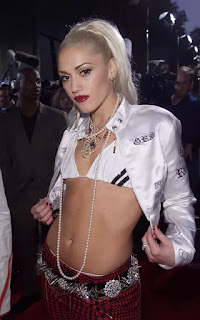Gwen Stefani
Gwen Stefani's been ripping them off
basically forever. It's the "chola look," a Mexican-American female aesthetic that's
now being appropriated by celebrities. Think white sleeveless undershirts,
Dickies pants with suspenders, thinly plucked eyebrows, maroon lips with a lot
of liner, big Aquanet-enabled bangs, and a general "don't mess with me" vibe.
Gwen Stefani is perhaps the poser
Chola-in-chief. In her music video for “Luxurious” she wore chanclas and shirts
with old English lettering. Even La Virgen de Guadalupe makes an appearance.
Gwen Stefani, whose 2004 Luxurious video places her as the only (blonde, glimmering)
white chola at a Mexican American barbecue, reflecting her upbringing in the majority-Latino city of
Anaheim, California. “I love other cultures, but I was most influenced
where I grew up in Anaheim, two hours from the Mexico border. The girls in
class would use a safety pin to separate their three-week-old mascara. It was
amazing.”
Earlier in the year, the
singer-fashion designer also gave props to her chola influencers, telling WWD
that “Chola girls … had
unbelievable makeup” and she was "mesmerized" while watching
them use their cosmetics in class.
We're happy that Stefani, who has long
been criticized of appropriating Latina and Japanese culture, is recognizing
where her beauty look comes from.
“Gwen Stefani made waves with her
video for "Luxurious," which had her dressed up as a chola out of
Westside Anaheim down to the eyeliner and flannel. Stefani told the press she
got the inspiration for the fashion from a chola named Mercedes back when she
was a student at Loara High School. Okay...but what was Mercedes' last name?
Who did she roll with? Did she end up dropping out of high school, or did she
grow out of it. Most importantly: did Gwen ever track her down and kick over a
couple of thou in royalties for stealing her bit?”
The Orange County-bred star’s other
major makeup influence? “Chola
girls…[they] had unbelievable makeup,” she said. “I grew up in Anaheim, [a]
super heavy Hispanic [population] you know…I would daydream and watch [the
girls] in class putting their makeup on, as people do when they’re in class,
and just be like, mesmerized.”




She’s an Edomite , that’s what devils do
ReplyDeleteShes half Mexican omg
ReplyDeleteShes half Mexican omg
ReplyDelete